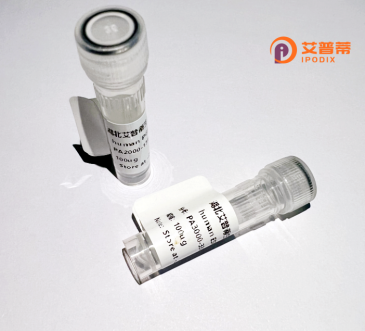
| 纯度 | >90%SDS-PAGE. |
| 种属 | Human |
| 靶点 | IL1F8 |
| Uniprot No | Q9NZH7 |
| 内毒素 | < 0.01EU/μg |
| 表达宿主 | E.coli |
| 表达区间 | 1-164aa |
| 氨基酸序列 | MNPQREAAPK SYAIRDSRQM VWVLSGNSLI AAPLSRSIKP VTLHLIACRD TEFSDKEKGN MVYLGIKGKD LCLFCAEIQG KPTLQLKLQG SQDNIGKDTC WKLVGIHTCI NLDVRESCFM GTLDQWGIGV GRKKWKSSFQ HHHLRKKDKD FSSMRTNIGM PGRM |
| 分子量 | 18.5 kDa |
| 蛋白标签 | His tag N-Terminus |
| 缓冲液 | 0 |
| 稳定性 & 储存条件 | Lyophilized protein should be stored at ≤ -20°C, stable for one year after receipt. Reconstituted protein solution can be stored at 2-8°C for 2-7 days. Aliquots of reconstituted samples are stable at ≤ -20°C for 3 months. |
| 复溶 | Always centrifuge tubes before opening.Do not mix by vortex or pipetting. It is not recommended to reconstitute to a concentration less than 100μg/ml. Dissolve the lyophilized protein in distilled water. Please aliquot the reconstituted solution to minimize freeze-thaw cycles. |
1. **"Structural characterization of recombinant human IL1F8 (IL-36α) and its inhibitory mechanism in inflammation"**
*作者:Towne, J.E. et al. (2011)*
**摘要**:该研究解析了重组人IL1F8蛋白的三维结构,发现其通过结合IL-36受体并招募IL-1受体辅助蛋白(IL-1RAcP)激活下游信号,揭示了其在银屑病等炎症疾病中的潜在作用机制。
2. **"IL-36α (IL1F8) amplifies proinflammatory responses in keratinocytes through MAPK and NF-κB pathways"**
*作者:Carrier, Y. et al. (2011)*
**摘要**:体外实验表明,重组IL1F8蛋白能显著激活角质形成细胞的促炎反应(如IL-6、IL-8分泌),依赖MAPK和NF-κB信号通路,提示其在皮肤炎症中的关键角色。
3. **"Targeting IL-36 in psoriatic disease: A novel therapeutic strategy"**
*作者:Boutet, M.A. et al. (2016)*
**摘要**:通过小鼠银屑病模型研究发现,重组IL1F8蛋白的过度表达加剧皮肤炎症,而阻断IL-36受体可减轻病理症状,为靶向IL1F8治疗银屑病提供依据。
4. **"Differential regulation of IL-36 family members in human monocytes and epithelial cells"**
*作者:Kumar, S. et al. (2013)*
**摘要**:研究比较了重组IL1F8与其他IL-36家族成员(如IL-36β/γ)在单核细胞和上皮细胞中的表达调控差异,发现其在细菌感染模型中特异性上调,提示其参与宿主免疫防御。
Recombinant human IL1F8 protein, also known as interleukin-36 alpha (IL-36α), is a member of the interleukin-1 (IL-1) cytokine family. It is encoded by the IL36A gene and functions as a pro-inflammatory mediator. Structurally, IL1F8 shares homology with other IL-1 family members, featuring a conserved β-trefoil fold. Unlike classical IL-1 cytokines, IL-36α requires proteolytic processing at its N-terminal region for full biological activity. It signals through the IL-36 receptor (IL-36R), which forms a heterodimer with the IL-1 receptor accessory protein (IL-1RAcP), activating downstream NF-κB and MAPK pathways to regulate immune responses.
IL-36α plays a critical role in skin and mucosal immunity, influencing processes like inflammation, epithelial cell proliferation, and wound healing. Dysregulation of IL-36 signaling is linked to inflammatory diseases, particularly psoriasis, where elevated IL-36α levels drive pathogenic keratinocyte activation and immune cell recruitment. Research on recombinant IL1F8 focuses on understanding its therapeutic potential. Agonists or antagonists targeting IL-36R are under investigation for treating autoimmune and chronic inflammatory disorders. Notably, IL-36 receptor antagonists (e.g., spesolimab) have shown efficacy in clinical trials for generalized pustular psoriasis.
Recombinant IL1F8 is produced using engineered cell systems (e.g., E. coli or mammalian cells) to ensure proper folding and bioactivity. Its study provides insights into innate immunity mechanisms and supports the development of targeted immunotherapies.
×